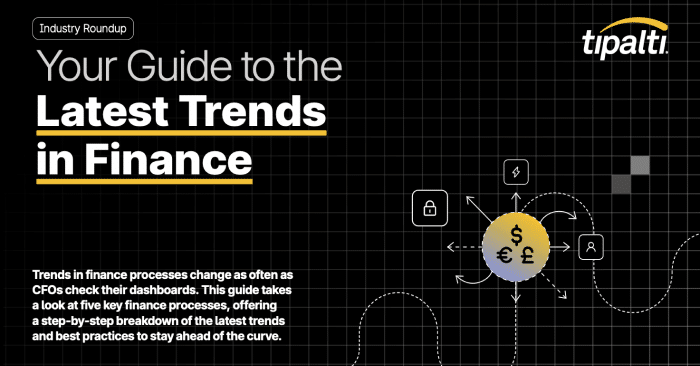
Finance trends shift fast—explore 5 key processes & tips to stay ahead.
Fill out the form to get your free eBook.

Trends in finance processes change as often as CFOs check their dashboards. This guide takes a look at five key finance processes, offering a step-by-step breakdown of the latest trends and best practices to stay ahead of the curve.
Congratulations on your new position as a controller! It’s a critical role in so many organizations and is difficult to define. Where do the CFO’s or treasurer’s role end and yours begin? How much accounting activity do you actually need to engage in? As the controller, will you be more policy definer or a glorified bookkeeper? Regardless, as the lynchpin between financial planning and finance operations, you can have a major impact.
Here are some ideas for creating an impact in your new role.
1. Remember to Take Control
Controllership of the organization means just that: you own the process. Beyond determining how certain funds are spent, it requires a take-charge personality to be a strong controller, otherwise, you are a glorified bookkeeper. In addition, to properly serve the CFO (and the company), the controller needs to spearhead transformation strategies.
The challenge in this is that your efforts involve change management and finance professionals are risk-averse. Yet everywhere else in the organization, there is pressure to perform and improve—from the CFO, CEO, and shareholders. As you take control, understand what the rewards are. For whatever transformational plan you have, consider what the payback is to your business, to your team, and ultimately to your own career.
2. Enable the Growth Potential
Growth is no good to an organization if it’s not done in a scalable, responsible way. As the controller, you’re overseeing a back-office function. It’s one that customarily is not profit-generating and, thus, costs the organization money to exist. Very rarely can you change the bottom line other than to streamline operations and reduce cost.
Finance’s most costly investment will always be in labor. As such, if you’re going to spend on headcount, you’re going to want to bring in personnel that offers the organization intrinsic and long-term value, rather than act as stopgaps broken, manual processes.
3. Strive for Greater Visibility
Visibility is the antidote to risk. The more you can see and the more accurately you can see, the better your ability to navigate around fraud, compliance issues, financial controls, and business obstacles. Identify processes and solutions that will maximize what data you see, without requiring more work.
This can be extremely impactful for current and future operational efforts. At any moment in time, if you can tell the CFO where the organization is benchmarking compared to other companies of similar size in the industry, it demonstrates a level of efficiency that actually protects your resources and expenditures. Controllers can minimize budget constraints for themselves when they’re able to show the effectiveness of their initiatives.
4. Assess the Situation
Why is this fourth? Shouldn’t it be first? Actually, no!
If you assess your situation too soon, oftentimes you fall into “group think” where things have a tendency to seem “okay,” and that makes it harder to implement useful changes. However, if you enter with goals of greater growth and visibility first, you can bring an outsider’s perspective that can actually drive transformation. Is it disruptive? Of course. But that’s how great work happens.
Recognize that all processes (AP, AR, payroll, expense management, etc.) can be better and that strategic finance is more impactful than menial bookkeeping. Done well, you’re able to elevate the entire finance operation.
5. Remove Organizational Concerns
With any level of transformation in an organization, change goes beyond signing a contract for technology. Implementing solutions requires you to articulate the change and bring people on board. It means acknowledging and addressing all of their concerns and making sure that they feel comfortable. They need to know they’re part of that transformation, and it’s not something coming from the top.
Efficiency and automation don’t mean people will necessarily lose their jobs. The work will change, and if you’ve chosen correctly, valued staff will have a place because the new work will be more fulfilling and career-enhancing for everyone. What you can stress is how much more their jobs will be intellectual, and thus valuable to the company. They’re going to be bringing more impact to the business.
6. Eliminate the Drudgery
The easiest win in finance transformation is to focus first on the drudge work. By taking away work no one really wants to do, you’re left with work that is at least challenging and higher level. Few can argue with this transformation, and fewer will fight it. And if they do, you have to question if they’re really a fit for the team.
